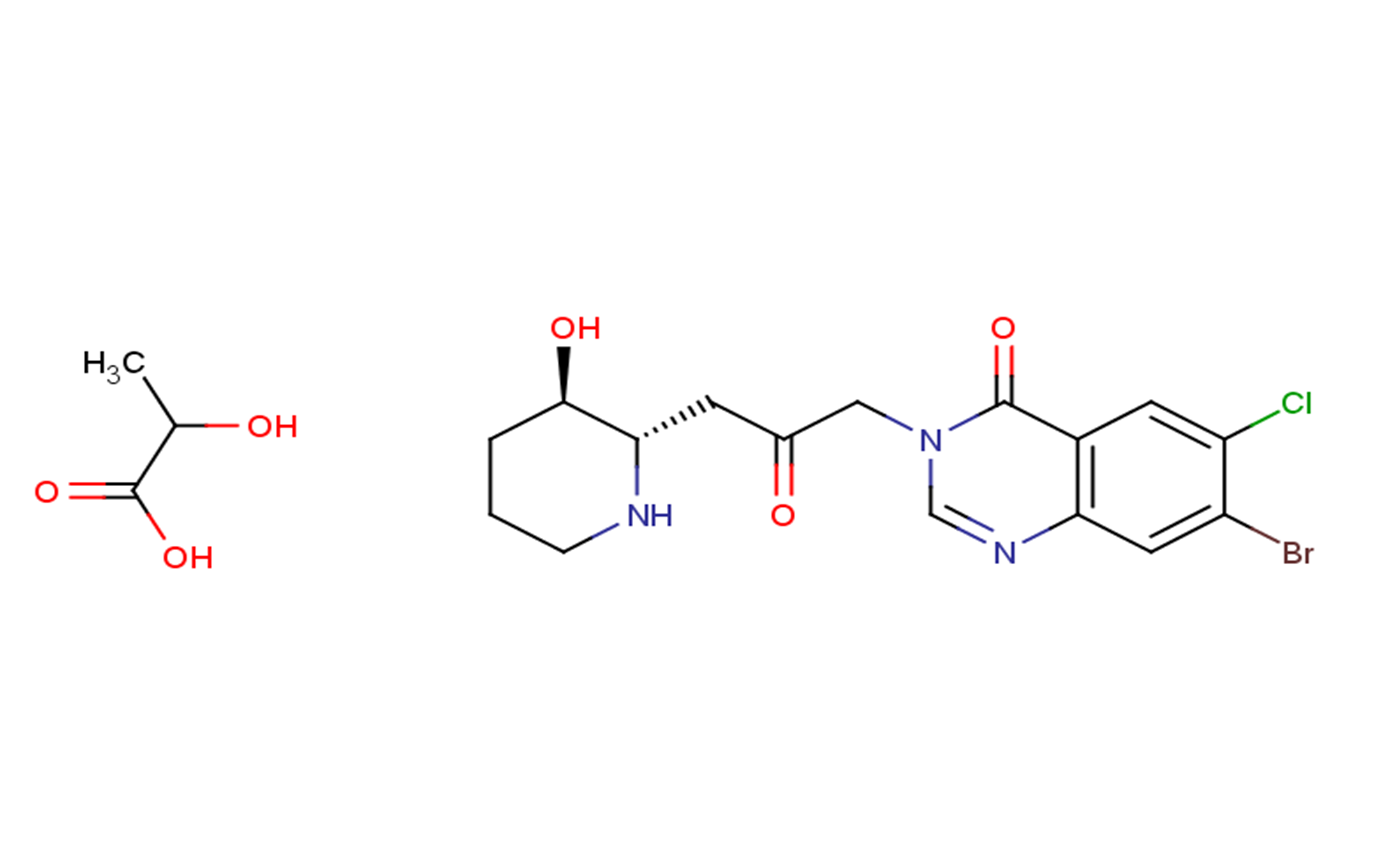
HALOFUGINONE LACTATE
CAS No. 82186-71-8
HALOFUGINONE LACTATE( —— )
Catalog No. M22897 CAS No. 82186-71-8
HALOFUGINONE LACTATE is a halogenated derivative of febrifugine, a natural quinazolinone-containing compound found in the Chinese herb D. febrifuga.Halofuginone inhibits prolyl-tRNA synthetase in an ATP-dependent manner with a Ki of 18.3 nM.?Halofuginone is a specific inhibitor of type-I collagen synthesis and attenuates osteoarthritis (OA) by inhibition of TGF-β activityhalofuginone (HF), a widely studied derivative of febrifugine, inhibits the development of T(H)17-driven autoimmunity in a mouse model of multiple sclerosis by activating the amino acid response (AAR) pathway.?HF binds glutamyl-prolyl-tRNA synthetase (EPRS), inhibiting prolyl-tRNA synthetase activity;?this inhibition is reversed by the addition of exogenous proline or EPRS.
Purity : >98% (HPLC)
 COA
COA
 Datasheet
Datasheet
 HNMR
HNMR
 HPLC
HPLC
 MSDS
MSDS
 Handing Instructions
Handing Instructions
| Size | Price / USD | Stock | Quantity |
| 2MG | 70 | In Stock |


|
| 5MG | 104 | In Stock |


|
| 10MG | 159 | In Stock |


|
| 25MG | 243 | In Stock |


|
| 50MG | 402 | In Stock |


|
| 100MG | 593 | In Stock |


|
| 500MG | 1242 | In Stock |


|
| 1G | Get Quote | In Stock |


|
Biological Information
-
Product NameHALOFUGINONE LACTATE
-
NoteResearch use only, not for human use.
-
Brief DescriptionHALOFUGINONE LACTATE is a halogenated derivative of febrifugine, a natural quinazolinone-containing compound found in the Chinese herb D. febrifuga.Halofuginone inhibits prolyl-tRNA synthetase in an ATP-dependent manner with a Ki of 18.3 nM.?Halofuginone is a specific inhibitor of type-I collagen synthesis and attenuates osteoarthritis (OA) by inhibition of TGF-β activityhalofuginone (HF), a widely studied derivative of febrifugine, inhibits the development of T(H)17-driven autoimmunity in a mouse model of multiple sclerosis by activating the amino acid response (AAR) pathway.?HF binds glutamyl-prolyl-tRNA synthetase (EPRS), inhibiting prolyl-tRNA synthetase activity;?this inhibition is reversed by the addition of exogenous proline or EPRS.
-
DescriptionHALOFUGINONE LACTATE is a halogenated derivative of febrifugine, a natural quinazolinone-containing compound found in the Chinese herb D. febrifuga.Halofuginone inhibits prolyl-tRNA synthetase in an ATP-dependent manner with a Ki of 18.3 nM.?Halofuginone is a specific inhibitor of type-I collagen synthesis and attenuates osteoarthritis (OA) by inhibition of TGF-β activityhalofuginone (HF), a widely studied derivative of febrifugine, inhibits the development of T(H)17-driven autoimmunity in a mouse model of multiple sclerosis by activating the amino acid response (AAR) pathway.?HF binds glutamyl-prolyl-tRNA synthetase (EPRS), inhibiting prolyl-tRNA synthetase activity;?this inhibition is reversed by the addition of exogenous proline or EPRS.
-
In Vitro——
-
In Vivo——
-
Synonyms——
-
PathwayCell Cycle/DNA Damage
-
TargetDNA/RNA Synthesis
-
Recptorprolyl-tRNA synthetase|TGF-β
-
Research AreaOthers
-
IndicationDuchenne muscular dystrophy
Chemical Information
-
CAS Number82186-71-8
-
Formula Weight504.8
-
Molecular FormulaC19H23BrClN3O6
-
Purity>98% (HPLC)
-
Solubility——
-
SMILESCC(O)C(O)=O.O=C1N(CC(C[C@@H]2NCCC[C@H]2O)=O)C=NC3=C1C=C(Cl)C(Br)=C3
-
Chemical Name——
Shipping & Storage Information
-
Storage(-20℃)
-
ShippingWith Ice Pack
-
Stability≥ 2 years
Reference
1. Keller TL, et al. Halofuginone and other Febrifugine derivatives inhibit prolyl-tRNA synthetase. Nat Chem Biol. 2012 Feb 12;8(3):311-7.
molnova catalog



related products
-
BVDV-IN-1
BVDV-IN-1 is a non-nucleoside inhibitor (NNI) of bovine viral diarrhea virus (BVDV), with an EC50 of 1.8 μM.?It directly binds to a hydrophobic pocket of the BVDV RdRp.
-
OPC 21268
OPC 21268 is a non-peptide Arginine vasopressin(AVP) Receptor V antagonist.
-
G150
G150 inhibited interferon expression triggered by DSDNA with IC50 of 10.2 nM.



 Cart
Cart
 sales@molnova.com
sales@molnova.com


